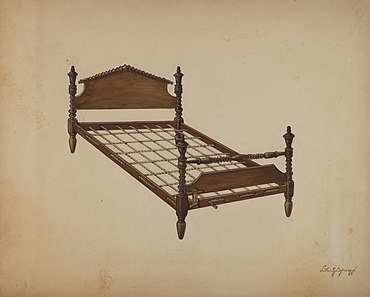Rope bed

A rope bed is a type of platform bed in which the sleeper (and mattress) is supported by a lattice of rope, rather than wooden slats.
In cold climates, a rope bed would be topped with one or more insulating pailasses or bedticks, which would traditionally be stuffed with straw, chaff, or down feathers. It might also have a canopy hung with warm curtains.[1][2] Modernly, they may be topped by a thin futon (a form of bedtick) or other roll-up mattress[3] (see mattress topper).
In the sixteenth century (England?), bedmats of woven or plaited rush were often laid on the widely-spaced ropes, and the bedticks were laid on the mats. This stopped them from bulging between the ropes.[4]
Rope beds need to be tightened regularly (with a bed wrench, and sometimes with wedges) as they sag. They must also be re-strung occasionally; re-stringing reduces sag and evens out wear.[5][3][6] When fully or partly unstrung, rope beds can be packed flat for transport.[3] The need to tighten bedcords has been said to be the origin of the English phrase "sleep tight", [4] but some etymologists disagree.[7]
-
Medieval-reconstruction rope beds (circa 1465); note loops of rope protruding from side boards
-
A rope bedframe thought to have belonged to William Shakespeare
-
Bedclothes pulled back to show the bedcords of the 1590s Great Bed of Ware
-
Touchable museum samples illustrating the layers of the Great Bed of Ware: the bedcords, a plaited-rush[8] bedmat, a flockbed and then a featherbed in dun ticking, a downbed in striped ticking, and the bedlinen.[4] Flock is unspun fibers, in this case probably wool. The bedticks stuffed with the softest fillings are laid topmost.
See also
- Charpai (warm-climate version)
- Bedtick
- Platform bed
- Murphy bed; some are rope (or wire) beds
![]() Media related to Rope bedframes at Wikimedia Commons
Media related to Rope bedframes at Wikimedia Commons
References
- ^ Karstensen, Rebecca (2018-01-18). Graves, Jean (ed.). "Sleep Tight, Don't Let the Bed Bugs Bite – A Myth Debunked". libraries.indiana.edu.
- ^ "Canopy beds and rope beds". Greydragon Furniture collection. (includes links to plans and information on tightening and use)
- ^ a b c Devin, Harold. "Making a Rope Bed" (PDF).
- ^ a b c Vredeman de Vries, Hans (September 28, 1998). "Great Bed of Ware". Victoria and Albert Museum: Explore the Collections. V&A Explore The Collections. Victoria and Albert Museum.
- ^ Wright, Bryan. "Colonial Sense: How-To Guides: Interior: Bed Roping". Colonial Sense.
- ^ "The Stamford Historical Society, A virtual tour through the Hoyt-Barnum House". www.stamfordhistory.org.
- ^ "What Is The Origin Of The Phrase "Sle... | Lexico.com". Lexico Dictionaries. Archived from the original on April 10, 2017.
- ^ "East Anglian rush", probably actually Scirpus, a sedge[1]




![Touchable museum samples illustrating the layers of the Great Bed of Ware: the bedcords, a plaited-rush[8] bedmat, a flockbed and then a featherbed in dun ticking, a downbed in striped ticking, and the bedlinen.[4] Flock is unspun fibers, in this case probably wool. The bedticks stuffed with the softest fillings are laid topmost.](http://upload.wikimedia.org/wikipedia/commons/thumb/5/51/Wikimania_2014_-_Victoria_and_Albert_Museum_-_The_Great_Bed_of_Ware221398.jpg/337px-Wikimania_2014_-_Victoria_and_Albert_Museum_-_The_Great_Bed_of_Ware221398.jpg)

